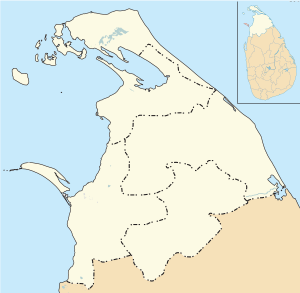| Delft Island Fort | |
|---|---|
| Neduntheevu, Sri Lanka | |
 Delft Island fort Delft Island fort | |
 | |
| Coordinates | 9°32′27″N 79°40′40″E / 9.540736°N 79.677769°E / 9.540736; 79.677769 |
| Type | Defence fort |
| Site information | |
| Condition | Ruins |
| Site history | |
| Built by | Portuguese |
| Materials | Limestone and coral |
Delft Island Fort (Tamil: நெடுந்தீவுக் கோட்டை, romanized: Neṭuntīvuk Kōṭṭai; Sinhala: ඩෙල්ෆ් බලකොටුව, romanized: Delf Balakotuwa, locally known as Neduntheevu fort and Meekaman fort) are ruins of a fort located on the island of Neduntheevu in the Palk Strait in northern Sri Lanka.
Traditionally attributed to the Karaiyar king Meekaman, the fort was probably built by the Portuguese. Later, it was taken over by Dutch, who built a barrack nearby. The island was known to the Portuguese as Ilha das Vacas ("Island of the Cows"), was renamed by the Dutch as Delft Island.
The fort was constructed out of limestone and coral. Though now in ruins, Ralph Henry Bassett describes the fort as a "very strongly fortified fort" in his book Romantic Ceylon: Its History, Legend, and Story.
References
- Devendra, D. T. (1969). "A Ruined Dagaba in Delft". The Journal of the Ceylon Branch of the Royal Asiatic Society of Great Britain & Ireland. 13: i–iii. ISSN 0304-2235. JSTOR 43483470.
- The Ceylon Antiquary and Literary Register. Vol. 8. Archeological Survey of India: Office Of The Times Of Ceylon. 1923. p. 252.
- "Delft Island Fort". Retrieved 9 November 2014.
- "Serenity pervades Delft Island". Sunday Observer. Archived from the original on 9 November 2014. Retrieved 9 November 2014.
- "Scenic beauty and historical significance of Delft Island". Daily Mirror. Retrieved 9 November 2014.
- Nelson, W. A.; de Silva, R. K. (2004). The Dutch Forts of Sri Lanka – The Military Monuments of Ceylon. Sri Lanka Netherlands Association.
| Ancient Forts |   | |
|---|---|---|
| Colonial Forts | ||
| Less or no contribution/renovation works of Dutch are marked by † symbol under "Portuguese Forts", and others are considered as Dutch forts too. | ||